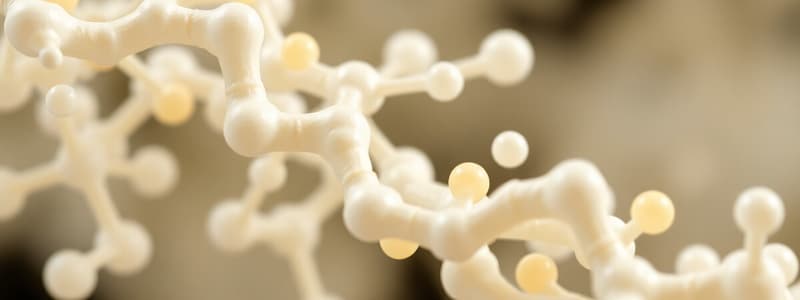Podcast
Questions and Answers
Polymers used in medicine are primarily made of repetitive units known as monomers.
Polymers used in medicine are primarily made of repetitive units known as monomers.
True (A)
Polymeric prodrugs are only formed from high molecular weight compounds.
Polymeric prodrugs are only formed from high molecular weight compounds.
False (B)
The main advantage of polymeric prodrugs is their ability to be absorbed through the skin more effectively than standard drugs.
The main advantage of polymeric prodrugs is their ability to be absorbed through the skin more effectively than standard drugs.
False (B)
Polymers used in drug delivery include PEG and PLGA.
Polymers used in drug delivery include PEG and PLGA.
Polymeric conjugates are characterized by the presence of only non-degradable bonds.
Polymeric conjugates are characterized by the presence of only non-degradable bonds.
The increase in water solubility provided by polymeric prodrugs contributes to enhanced drug bioavailability.
The increase in water solubility provided by polymeric prodrugs contributes to enhanced drug bioavailability.
Poly (ethylene glycol) (PEG) reduces protein immunogenicity and increases plasma stability when conjugated with protein drugs.
Poly (ethylene glycol) (PEG) reduces protein immunogenicity and increases plasma stability when conjugated with protein drugs.
Polymeric prodrugs can reduce the systemic toxicity of the drugs they carry.
Polymeric prodrugs can reduce the systemic toxicity of the drugs they carry.
The presence of multiple reactive functional groups simplifies the synthesis of bioconjugates.
The presence of multiple reactive functional groups simplifies the synthesis of bioconjugates.
All polymeric prodrugs are unstable at varied physiological pHs.
All polymeric prodrugs are unstable at varied physiological pHs.
Dicyclohexyl carbodiimide (DCC) is not used as a coupling agent in the formation of bioconjugates.
Dicyclohexyl carbodiimide (DCC) is not used as a coupling agent in the formation of bioconjugates.
An advanced drug delivery system using polymeric prodrugs can include additional active components.
An advanced drug delivery system using polymeric prodrugs can include additional active components.
Covalent bonds formed between drugs and polymers are known to be unstable and readily release their drug payloads.
Covalent bonds formed between drugs and polymers are known to be unstable and readily release their drug payloads.
N-(2-hydroxypropyl)methacrylamide is an example of a polymer used in clinical research.
N-(2-hydroxypropyl)methacrylamide is an example of a polymer used in clinical research.
High molecular weight prodrugs are developed specifically to enhance peripheral side effects during cancer treatment.
High molecular weight prodrugs are developed specifically to enhance peripheral side effects during cancer treatment.
Polymer–drug conjugates can be engineered to be activated by specific enzymes that release the parent drug in situ.
Polymer–drug conjugates can be engineered to be activated by specific enzymes that release the parent drug in situ.
The Drug Delivery System (DDS) allows for targeting specific organelles within cells and can control the timing of drug release.
The Drug Delivery System (DDS) allows for targeting specific organelles within cells and can control the timing of drug release.
Prodrugs that combine two or more substances become active only outside the cell under normal conditions.
Prodrugs that combine two or more substances become active only outside the cell under normal conditions.
Steric hindrance does not affect the successful bioconjugation of protein drugs to synthetic polymers.
Steric hindrance does not affect the successful bioconjugation of protein drugs to synthetic polymers.
Nitrogen atoms in –NH2 groups are commonly used as reactive sites in bioconjugate synthesis.
Nitrogen atoms in –NH2 groups are commonly used as reactive sites in bioconjugate synthesis.
A polymeric prodrug model must include a targeting moiety, a carrier, and two or more active components.
A polymeric prodrug model must include a targeting moiety, a carrier, and two or more active components.
The carrier in drug delivery can only be an inert biodegradable polymer.
The carrier in drug delivery can only be an inert biodegradable polymer.
Polymers for macromolecular prodrugs can be categorized based only on their molecular weight.
Polymers for macromolecular prodrugs can be categorized based only on their molecular weight.
The selection of the spacer arm in polymeric drug delivery systems is not crucial.
The selection of the spacer arm in polymeric drug delivery systems is not crucial.
N-hydroxysuccinimide (NHS) ester is preferred for coupling reactions because of its lower reactivity at physiological pH.
N-hydroxysuccinimide (NHS) ester is preferred for coupling reactions because of its lower reactivity at physiological pH.
Biologically active prodrug conjugates can contain biomolecules such as proteins, peptides, and nucleic acids.
Biologically active prodrug conjugates can contain biomolecules such as proteins, peptides, and nucleic acids.
The most challenging aspect of the polymeric drug delivery system is the potential for altering the body distribution and cellular uptake.
The most challenging aspect of the polymeric drug delivery system is the potential for altering the body distribution and cellular uptake.
Reactive functional groups in the polymer are irrelevant for chemical conjugation with biomolecules.
Reactive functional groups in the polymer are irrelevant for chemical conjugation with biomolecules.
Oligomers, macromers, and polymers refer to different categories based on molecular weight in the context of PDDS.
Oligomers, macromers, and polymers refer to different categories based on molecular weight in the context of PDDS.
Chemical reactions for modifying a polymer to form prodrug conjugates rely on interrelated chemical reactions involving functional groups.
Chemical reactions for modifying a polymer to form prodrug conjugates rely on interrelated chemical reactions involving functional groups.
Flashcards
Polymer
Polymer
A large molecule composed of repeating structural units called monomers.
Biopolymers
Biopolymers
Polymers produced by living organisms. Examples include cellulose, starch, chitin, proteins, peptides, DNA, and RNA.
Polymeric prodrug
Polymeric prodrug
A prodrug where a drug molecule is attached to a polymer chain. This alters the drug's properties and can improve its delivery or effectiveness.
Increased water solubility in polymeric prodrugs
Increased water solubility in polymeric prodrugs
Signup and view all the flashcards
Protection of drug activity in polymeric prodrugs
Protection of drug activity in polymeric prodrugs
Signup and view all the flashcards
Targeting in polymeric prodrugs
Targeting in polymeric prodrugs
Signup and view all the flashcards
Reduced toxicity in polymeric prodrugs
Reduced toxicity in polymeric prodrugs
Signup and view all the flashcards
Increased cellular entry in polymeric prodrugs
Increased cellular entry in polymeric prodrugs
Signup and view all the flashcards
Suitable drug properties for polymeric conjugation
Suitable drug properties for polymeric conjugation
Signup and view all the flashcards
Examples of polymeric prodrugs
Examples of polymeric prodrugs
Signup and view all the flashcards
What is polyethylene glycol (PEG)?
What is polyethylene glycol (PEG)?
Signup and view all the flashcards
What is PEGylation?
What is PEGylation?
Signup and view all the flashcards
How does PEGylation increase plasma stability?
How does PEGylation increase plasma stability?
Signup and view all the flashcards
How does PEGylation reduce immunogenicity?
How does PEGylation reduce immunogenicity?
Signup and view all the flashcards
How can PEGylation increase the therapeutic index?
How can PEGylation increase the therapeutic index?
Signup and view all the flashcards
What factors influence the effectiveness of PEGylation?
What factors influence the effectiveness of PEGylation?
Signup and view all the flashcards
What are polymeric prodrugs?
What are polymeric prodrugs?
Signup and view all the flashcards
How do prodrugs type 1 work?
How do prodrugs type 1 work?
Signup and view all the flashcards
How do prodrugs type 2 work?
How do prodrugs type 2 work?
Signup and view all the flashcards
What are the advantages of polymeric prodrugs?
What are the advantages of polymeric prodrugs?
Signup and view all the flashcards
What is a polymeric prodrug?
What is a polymeric prodrug?
Signup and view all the flashcards
What is the role of the polymer backbone in a polymeric prodrug?
What is the role of the polymer backbone in a polymeric prodrug?
Signup and view all the flashcards
Why are spacers important in polymeric prodrugs?
Why are spacers important in polymeric prodrugs?
Signup and view all the flashcards
What is the function of an imaging agent in a polymeric prodrug?
What is the function of an imaging agent in a polymeric prodrug?
Signup and view all the flashcards
What is the role of a targeting moiety?
What is the role of a targeting moiety?
Signup and view all the flashcards
What is a conjugation reaction in polymeric prodrug synthesis?
What is a conjugation reaction in polymeric prodrug synthesis?
Signup and view all the flashcards
What is the NHS ester method in polymeric prodrug synthesis?
What is the NHS ester method in polymeric prodrug synthesis?
Signup and view all the flashcards
What is drug release in polymeric prodrugs?
What is drug release in polymeric prodrugs?
Signup and view all the flashcards
What is the key challenge in designing a polymeric prodrug?
What is the key challenge in designing a polymeric prodrug?
Signup and view all the flashcards
What is a polymeric drug delivery system (PDDS)?
What is a polymeric drug delivery system (PDDS)?
Signup and view all the flashcards
Study Notes
Polymeric Prodrugs
- Polymers, including biopolymers, are made of repetitive units called monomers
- Biopolymers are polymers produced by living organisms
- Examples of biopolymers include cellulose, starch, chitin, proteins, peptides, DNA, and RNA
- The monomers of these biopolymers are sugars, amino acids, and nucleotides, respectively
Polymer as a Carrier
- Polymers are used to deliver drugs, proteins, targeting molecules, and imaging agents
- Several polymers are used in clinical research, including:
- poly(ethylene glycol) (PEG)
- N-(2-hydroxypropyl)methacrylamide (HPMA)
- poly(lactide-co-glycolide) (PLGA) copolymers
- Conjugation of a drug with a polymer forms a polymeric prodrug
- Polymer conjugates can have degradable or non-degradable bonds
Advantages of Polymeric Prodrugs
- Increased water solubility of insoluble drugs, leading to enhanced bioavailability
- Protection of the drug from deactivation and preservation of its activity during transport and intracellular trafficking
- Improved pharmacokinetics
- Reduced antigenic activity of the drug, leading to a less pronounced immunological response
- Ability to provide passive or active targeting of the drug to its site of action
- Possibility to form an advanced complex drug delivery system
Successful Bioconjugation
- Factors that affect successful bioconjugation include the chemical structure, molecular weight, steric hindrance, and the reactivity of the biomolecule and the polymer
- Chemical entities like -COOH, – ОН, –SH, or –NH2 are needed to synthesize a bioconjugate
Strategies to Bind Drug with Polymer
- Common strategies involve coupling agents like dicyclohexyl carbodiimide (DCC) or N-hydroxysuccinimide esters
- Covalent bonds (ester, amide, and disulfide) are crucial to deliver drugs to the target site
- Polymer prodrugs are often designed for anticancer delivery
Design and Synthesis of Polymeric Prodrugs
- The most effective prodrug approach uses advanced drug delivery systems (DDS)
- DDS can target specific organs, cells, or organelles
- DDS may release the drug at specific times
Three Major Types of Polymeric Prodrugs
- Prodrugs that break down into active substances within cells
- Prodrugs combining two or more substances, reacting to create an active drug under intracellular conditions
- Prodrugs with three components: a targeting moiety, a carrier, and one or more active components
Ideal Polymeric Prodrug Model
- Consists of a polymeric backbone (vehicle), biological active components, a spacer for hydrolysis and versatility, an imaging agent, and a targeting moiety
Drug Delivery Carrier
- Can be a biocompatible or inert biodegradable polymer
- Drug is coupled to the polymer backbone directly or via a spacer arm
- The spacer arm controls the release of the active drug using hydrolysis or enzymatic degradation
- Cellular uptake can be altered by specific or non-specific uptake enhancers
Categorization of Polymers
- Chemical nature (e.g., vinylic or acrylic polymers, polysaccharides, poly amino acids)
- Biodegradability
- Origin (natural or synthetic)
- Molecular weight (oligomers, macromers, polymers)
Polymeric Drug Delivery System (PDDS)
- Modifying a polymer to form a conjugate with a biomolecule using two reactions
- Reactive functional groups present in the polymer
- Functional groups present on the biological component
- Most biomolecules possess combinations of functional groups
- Method, process, and reagents are crucial for successful chemical conjugation
Common Strategies for Bioconjugation
- N-hydroxysuccinimide (NHS) esters for high reactivity at physiological pH
- Incorporation of spacers to decrease crowding and steric hindrance; enhancing ligand-protein binding
- Carbodiimide coupling reactions (DCC) for obtaining chemical conjugates; smallest reagents are zero length cross-linkers
Studying That Suits You
Use AI to generate personalized quizzes and flashcards to suit your learning preferences.




